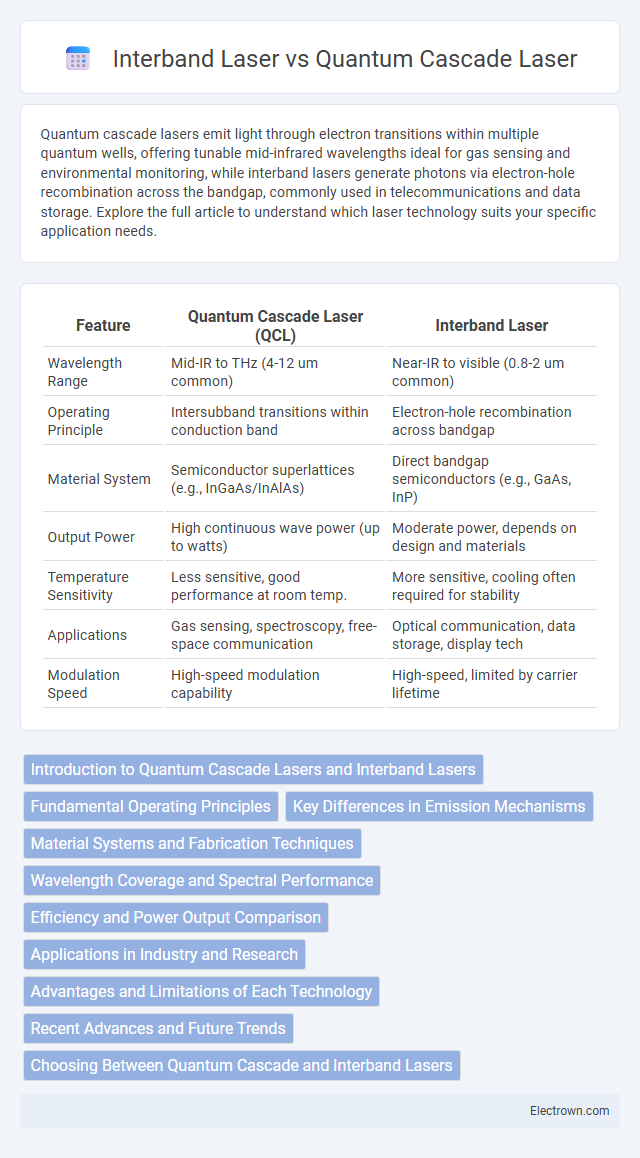Quantum cascade lasers emit light through electron transitions within multiple quantum wells, offering tunable mid-infrared wavelengths ideal for gas sensing and environmental monitoring, while interband lasers generate photons via electron-hole recombination across the bandgap, commonly used in telecommunications and data storage. Explore the full article to understand which laser technology suits your specific application needs.
Table of Comparison
| Feature | Quantum Cascade Laser (QCL) | Interband Laser |
|---|---|---|
| Wavelength Range | Mid-IR to THz (4-12 um common) | Near-IR to visible (0.8-2 um common) |
| Operating Principle | Intersubband transitions within conduction band | Electron-hole recombination across bandgap |
| Material System | Semiconductor superlattices (e.g., InGaAs/InAlAs) | Direct bandgap semiconductors (e.g., GaAs, InP) |
| Output Power | High continuous wave power (up to watts) | Moderate power, depends on design and materials |
| Temperature Sensitivity | Less sensitive, good performance at room temp. | More sensitive, cooling often required for stability |
| Applications | Gas sensing, spectroscopy, free-space communication | Optical communication, data storage, display tech |
| Modulation Speed | High-speed modulation capability | High-speed, limited by carrier lifetime |
Introduction to Quantum Cascade Lasers and Interband Lasers
Quantum cascade lasers (QCLs) operate based on intersubband transitions within the conduction band of semiconductor superlattices, enabling efficient mid-infrared to terahertz wavelength emission. Interband lasers emit light through electron-hole recombination across the bandgap, commonly used in near-infrared to visible spectra such as diode lasers. Your choice between quantum cascade lasers and interband lasers depends on the targeted wavelength range and application, with QCLs favored for mid-infrared sensing and interband lasers preferred for telecommunications and optical data storage.
Fundamental Operating Principles
Quantum cascade lasers operate based on intersubband transitions within the conduction band of semiconductor superlattices, where electrons cascade down multiple quantum wells emitting photons at each step. Interband lasers rely on electron-hole recombination across the bandgap between the conduction and valence bands, generating photons with energy corresponding to the bandgap. The distinct operating principles lead to differing emission wavelengths, with QCLs typically producing mid-infrared to terahertz radiation, while interband lasers commonly emit in the near-infrared to visible spectrum.
Key Differences in Emission Mechanisms
Quantum cascade lasers (QCLs) use intersubband transitions within the conduction band of a semiconductor superlattice, relying on electron tunneling between quantum wells to produce mid-infrared to terahertz emissions. Interband lasers operate through electron-hole recombination across the bandgap, emitting photons typically in the near-infrared to visible spectrum. The QCL's unipolar mechanism allows wavelength tuning via quantum well engineering, whereas interband lasers depend on material bandgap properties for fixed emission wavelengths.
Material Systems and Fabrication Techniques
Quantum cascade lasers utilize complex III-V semiconductor heterostructures like InGaAs/InAlAs grown on InP substrates through molecular beam epitaxy or metal-organic chemical vapor deposition, enabling precise control of layer thickness for tailored wavelength emission. Interband lasers commonly employ direct bandgap materials such as GaAs/AlGaAs or InGaAsP/InP systems, fabricated using epitaxial methods optimized for efficient electron-hole recombination across the bandgap. Your choice between these lasers depends on the desired emission wavelength and fabrication complexity tied to their distinct material compositions and growth techniques.
Wavelength Coverage and Spectral Performance
Quantum cascade lasers (QCLs) offer extensive wavelength coverage in the mid-infrared range, typically from 4 to 12 micrometers, enabling precise molecular fingerprinting and environmental sensing. Interband lasers primarily cover the near-infrared to the visible spectrum, generally from 0.8 to 2 micrometers, making them ideal for telecommunications and medical applications. Your choice between these lasers depends on the required spectral performance, with QCLs providing tunable, narrow linewidth output and interband lasers offering higher power efficiency and faster modulation speeds.
Efficiency and Power Output Comparison
Quantum cascade lasers (QCLs) typically offer higher power output and efficiency in the mid-infrared to terahertz range compared to interband lasers, which are more common in the near-infrared spectrum. The unipolar design of QCLs enables efficient electron transitions within the conduction band, resulting in better thermal management and scalability for high-power applications. Your choice between these lasers depends on the required wavelength, with QCLs excelling in efficiency and power for longer wavelengths while interband lasers perform well at shorter wavelengths with moderate output.
Applications in Industry and Research
Quantum cascade lasers (QCLs) are extensively used in mid-infrared spectroscopy, environmental monitoring, and chemical sensing due to their tunable wavelengths and high power outputs, making them ideal for precise industrial gas analysis. Interband lasers, with their efficient near-infrared emission, are preferred in telecommunications, medical diagnostics, and data storage applications where speed and integration with silicon photonics are critical. Your choice between QCLs and interband lasers should consider the specific wavelength requirements and operational environments pertinent to your industrial or research application.
Advantages and Limitations of Each Technology
Quantum cascade lasers offer superior wavelength tunability and high power output in the mid-infrared range, making them ideal for gas sensing and spectroscopy applications. Interband lasers provide efficient light emission at shorter wavelengths with simpler diode structures, suitable for telecommunications and medical devices. Your choice depends on the required wavelength, efficiency, and application-specific performance constraints.
Recent Advances and Future Trends
Recent advances in quantum cascade lasers (QCLs) highlight improvements in mid-infrared emission efficiency, thermal management, and wavelength tunability, enabling applications in environmental sensing and medical diagnostics. Interband lasers have seen progress in broadband emission and high-speed modulation, which foster innovations in optical communications and on-chip photonics. Future trends forecast integration of QCLs with photonic circuits and exploration of novel semiconductor materials in interband lasers for enhanced performance and stability.
Choosing Between Quantum Cascade and Interband Lasers
Quantum cascade lasers (QCLs) excel in mid-infrared applications due to their unipolar operation and customized wavelength emission, making them ideal for gas sensing and spectroscopy. Interband lasers, operating on electron-hole recombination, offer advantages in near-infrared communications and high-speed data transmission with higher modulation bandwidths. Selecting between QCLs and interband lasers depends on required emission wavelength, application-specific performance metrics, and device integration capabilities.
quantum cascade laser vs interband laser Infographic

 electrown.com
electrown.com